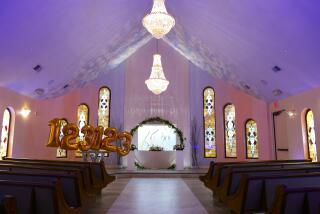Hitch to Year-End Nuptials : Higher Taxes, Costs Make Dec. 31 Vows Expensive : WEDDING: Costs of Dec. 31 Nuptials Are Taxing
- Share via
Andrew Fox thought it would be a kick to get married on New Year’s Eve. He and fiancee Cathy Cornett sent their friends party invitations that only briefly mention the nuptials.
“We thought it would be a great thing to have a party around,” says Fox, 26, of Austin, Tex.
Fox is not alone. While more people get married on the last Saturday in June than any other day of the year, Dec. 31 consistently ranks among the nation’s most popular wedding dates, says Alan Fields, author of the book “Bridal Bargains.”
Roughly 18,000 couples will tie the knot this New Year’s Eve, 1,000 more than will wed on Valentine’s Day next year, according to an official at the U.S. Bureau of Health Statistics.
Unfortunately, the one thing many love-struck couples fail to realize is that the cost of a New Year’s Eve wedding can be substantial--far more, in fact, than a wedding at nearly any other time of the year. The reasons: competition and taxes.
“New Year’s Eve is a time when there is more demand for all party services,” says Dick Ashmore, owner of Party Spectrum, a party planning company in Temple City. “The price for renting a band, orchestra, disc jockey, limousine, hall or hotel ballroom is much more expensive.”
A Dec. 31 wedding lands many couples a substantial tax bill as well.
As far as tax authorities are concerned, couples who marry in December pay taxes as if they’d been married all year long. And husband and wife pay more tax than unwed men and women because of something called the “marriage penalty.”
Exactly how much more does it cost to marry on New Year’s Eve than any other day of the year?
The answer depends on the couple’s income and party plans, of course. But on average, you’d spend about 20% more on the wedding alone, says Fields. That’s mainly because two of the biggest costs--catering and entertainment--jump dramatically on New Year’s Eve, he says.
The cost of hiring a band, for example, would normally run $1,000. But most bands double the price on Dec. 31. The cost of catering would rise about 20% to about $10,000, from roughly $8,000 for your average 200-person wedding, Fields says.
Those who want to hire a limousine to drive the happy couple hither and yon will also pay a premium, experts note. Limousine services say they either boost their hourly rate or boost the minimum number of hours the car must be rented. Either way, the cost of a limousine rental usually doubles, from about $200 to roughly $400.
Federal taxes will set you back by about another $1,300 if you’re an average two-income couple, experts say. But if you both earn lots of money, the marriage penalty is stiffer--$3,500 or more, depending on your income.
How so? Consider a hypothetical couple, whom we’ll call John and Mary Bliss. John earns $30,000 annually. So does Mary. Neither has any substantial tax deductions.
If they wait until Jan. 1 to marry, each would pay $3,840 in federal taxes for 1993--a total of $7,680. If they marry Dec. 31, their 1993 federal tax liability jumps to $8,958. The $1,278 difference is the marriage penalty.
If John and Mary each earns $90,000, their marriage penalty would amount to $3,547 in 1993.
Explaining how the marriage penalty works is complicated. However, the short version is that even though one person who earns $50,000 is in the 28% federal tax bracket, two people earning $50,000 each would be pushed into the 31% bracket. Tax authorities justify the penalty by noting that two people living together live more cheaply than two people living alone. But there’s no tax penalty for having a roommate--only for getting married.
If the Blisses wait a day to wed, they’ll avoid the marriage penalty for one year. They’ll pay it in 1994, of course. But they’ll permanently save what they would have otherwise had to pay for the 1993 tax year.
Ironically, many attribute the tradition of New Year’s Eve weddings to a pre-1967 tax break for married couples.
Prior to 1967, there were simply two tax rates--one for heads of households and one for everyone else, says Tom Rutherford, executive editor at Commerce Clearing House, a Chicago-based tax information service. When people wed in the early 1960s, both spouses were able to use the lower head-of-household tax rates. And from a tax standpoint, that meant it was almost always cheaper to be married.
But after 1967, the government created four different tax tables: one for head of household, another for married couples filing separately, one for married couples filing jointly and a fourth for single filers.
Technically, that’s when the marriage penalty started. Practically speaking, however, it didn’t cost any real money until women started working in large numbers--and earning more money.
In fact, says Rutherford, you avoid the marriage penalty if one spouse earns less than 20% of the income of the other. But that’s somewhat unusual these days, particularly with young couples.
The significance of these facts hasn’t been lost on young Andrew Fox.
“We’re not going to change the date,” he says. “But we’re probably going to wait until 12:01 to say ‘I do.’ ”
Cost of a New Year’s Wedding The prices of a number of items soar when you get married on New Year’s Eve compared to the rest of the year. Here’s a breakdown: Entertainment (5-piece band) Usual cost: $1,000 New Year’s Eve cost: $2,000 Catering, (200 people) Usual cost: $8,000 New Year’s Eve cost: $10,000 Limousine rental Usual cost: $200 New Year’s Eve cost: $400 Flowers* Usual cost: $750 New Year’s Eve cost: $675 Photographer Usual cost: $1,500 New Year’s Eve cost: $1,500 Total Usual cost: $11,450 New Year’s Eve cost: $14,575 * Flowers for bouquets and reception will run 10% to 20% more, but you probably won’t have to decorate the church because many will still have holiday displays in place. Sources: Alan Field, author of “Bridal Bargains”; limousine rental companies
More to Read
Sign up for Essential California
The most important California stories and recommendations in your inbox every morning.
You may occasionally receive promotional content from the Los Angeles Times.













